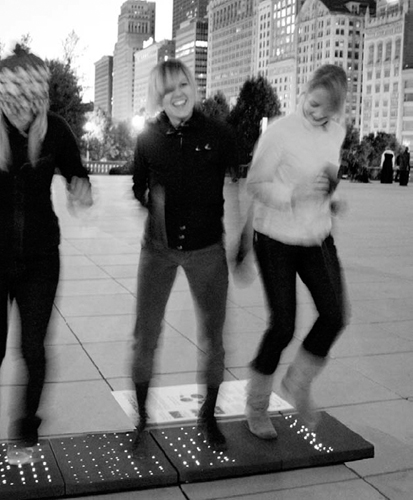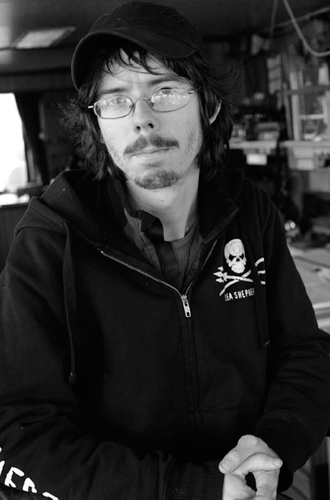The Next Eco-Warriors (21 page)
Read The Next Eco-Warriors Online
Authors: Emily Hunter
We are a global network. All our individual choices create a ripple effect and will eventually impact millions. Once we realize that, we can each find our own place and let the ripples move further and further out
.
I didn't have to wait long. I was on a long weekend from work and went to Ohio to visit my good friend from college Mavilya (Mia) Chubarova. Mia was my partner in crime at university. Our art studios were next to each other, and we were the only ones who stayed into the wee hours of the night plugging away at our projects. We had passion, and we were like sisters. As you can imagine, the magazine submission was far from my mind the moment I arrived in Columbus and saw Mia. As we sat giggling over a shared joke, my cell phone rang. I answered it for some reason, which is rare because I am a notorious screener.
It was the editor from
Metropolis Magazine
. My heart skipped a beat as she informed me that I had been selected as a runner-up in the competition. Her voice was warm and friendly, and her support for the project became
clear: “Now I only request one thing—that you come up with a better name than Project Power Struggle. What is that? This is a fantastic and exciting product that can change people's behavior and the world! Show it!”
As I hung up the phone, I had goose bumps from her words. It took a moment to truly realize the potential of this opportunity. I looked at Mia; she knew exactly what had just ensued. We cried with excitement, opened a bottle of champagne, and immediately took out a piece of paper to start brainstorming names as we used to do in school. Our favorites: the Electric Stride and POWERleap.
After the weekend, I immediately went back to work on the project, as I had to prepare for a reception ceremony in San Francisco. It would be the first time I would present my innovation under its new name, POWERleap. After the excitement of the editor's phone call, doubt and anxiety crept back into my life. I realized that although my idea was fresh, I didn't have a prototype that I felt was appropriate to show off at the reception. Suddenly, I felt too young and foolish to be taken seriously. After all, I would be competing against seasoned engineers and professional designers. Who was I? I was a recent graduate working for my sister.
The night before the reception, I couldn't sleep. I kept thinking about my pitch and how I would talk about POWERleap. I was overwhelmed by confusion— so much to say and only one shot! I was scared of being made out a fool, to say the least. That morning I had breakfast with my brother Joe in San Francisco. Joe is four years older than me, and he was always one of my biggest fans. Sitting across from my eggs over easy and toast, he could tell my head was hanging low. He reminded me of the day I learned how to ride a bike. “Remember how determined you were? You were taken over by this goal. Just remember what it is you want to accomplish today, and you are going to touch the masses.” That conversation stuck with me all day, and when I walked into the showroom, all of my fears had melted away. I didn't have an idle moment.
The week after the reception ceremony, I was contacted by Mohawk Group—a global commercial carpet manufacturer. They were cosponsors of the competition that year and, to my great pleasure, they took quite a
liking to POWERleap. They followed up after the reception with some phone and email correspondence to learn more about my project and its direction. Before I knew it, I was being flown into Atlanta for a meeting. As a result of the meeting, they agreed to give me a ten-thousand-dollar grant to build my Next Generation prototype to be showcased on a segment for the Sundance Channel. Working day and night, I frantically studied and tried putting everything together before the television shoot. Everything started
to come together quickly—I incorporated my business, collected two business partners, launched a website, spoke with fifty-plus potential commercial customers, and filed a provisional patent. I started getting emails and calls from media outlets like National Public Radio, the
New York Times
, and
TreeHugger.com
all remarking on the possibilities of the project and wanting to report it to the world.

PHOTO BY POWERLEAP
At the time of this writing, we are finalizing a business agreement and planning our first set of commercial pilot installations. We have a number of customers lined up to be our initial testers, and finally I can tell them approximately when our doors will open. POWERleap today is not just a new source of alternative energy, it also represents an alternative pathway of how we can think about and take responsibility for the energy we use.
I consider myself an entrepreneur working for the planet. I realize that working within corporate models for change isn't seen as the traditional form of activism, but I feel as though I have defined my own form of activism. I never imagined myself owning an American business and sustaining myself through a capitalist market system. Yet when the opportunity presented itself, I didn't turn it away. I don't operate my business in a way that lets life go by, selfishly taking without giving back. Instead, I found a way to harness my passion and commitment to environmental activism into full-time work that is rewarding personally, financially, and environmentally. I strongly feel that we are a global network. All our individual choices create a ripple effect and will eventually impact millions. Once we realize that, we can each find our own place and let the ripples move further and further out. For this reason, I remain dedicated to developing technology that goes beyond harnessing the energy of the wind and sun. To truly make the switch from dirty fossil fuels, we need to exhaust every possibility of energy production, which calls for continual research, innovation, and guts. And I'm happy to drive that train in any way I can.
When I was a three-year-old learning to ride a bike, I refused to let go of a dream. Today, that dream is not a brass horn, but a new kind of energy future. And for me to achieve that dream, it means running a company that will hopefully one day change the way we use energy in a more sustainable
and productive way. With the state of our planet right now, that day can't come soon enough.
_________
Elizabeth Redmond is the president and director of POWERleap Inc., a cleantech company that generates electricity from pedestrian and vehicular traffic. Since its inception in 2006, POWERleap has now grown to become a global corporation showcased on the Discovery Channel, Sundance Channel
, The New York Times,
and
Forbes.
Elizabeth plans to continue to use design to fuel the engines of change and innovate alternatives for our future
.
 Twenty-five
Twenty-five Sweden
Sweden Animal Defender
Animal Defender

PHOTO BY JO-ANNE MCARTHUR
Bring on your tear gas, bring on your grenades, your new supplies of mace, your state troopers, and even your national guards. But let the record show, we ain't going to be turned around
.
—RALPH DAVID ABERNATHY
IT WAS APRIL, 12, 2008, when a heavily armed tactical response unit of the Royal Canadian Mounted Police (RCMP) boarded my vessel by force in international waters. They stormed the wheelhouse and pushed me and the captain down to the deck at gunpoint. I was told to put my hands on my head and not to move. Throughout the ship, the heavy thud of combat boots echoed down narrow wooden companionways, drowning out the screams of the rest of the crew as they too were forced to the deck. Five minutes after boarding, the storm troopers had secured the ship.
In groups of four, we were moved onto a Canadian Coast Guard icebreaker. We were handcuffed to a railing that ran along the vessel's starboard side. From there, I could see the RCMP comb through the ship, referred to affectionately by the crew as “the old
Farley
,” that had been my home for almost five years. We were taken to Sydney, Nova Scotia, past the heavy ice floes that we'd negotiated several days earlier when first entering the Gulf of St. Lawrence. The M/V
Farley Mowat
was put under tow, and the single-largest mass slaughter of marine mammals in the world, the Canadian seal hunt, would continue virtually unopposed dozens of miles in our wake.
The captain of my vessel, Alex Cornelissen, and I were subsequently moved to an RCMP detention center on a First Nations reservation, twenty-five minutes out of Sydney. I was brought in front of Canadian Customs as if
I had flown into the country rather than having been forced in at gunpoint. As I stood in front of them, all my possessions having been confiscated, all of my clothes beyond a t-shirt and pants taken away from me, they asked me if I had “anything to declare.” I didn't answer. They proceeded to ask me the usual Canadian Customs questions: if I was bringing any plants or animals into the country, if I was bringing ten thousand dollars or more into the country. I chose to remain silent.
As I pulled up my first hook and saw it gleam under the moonlight, I knew that that specific hook wasn't going to kill another seal, sea turtle, or tuna ever again. And to think that it didn't make a difference was completely wrong—it made all the difference in the world to that one animal
.